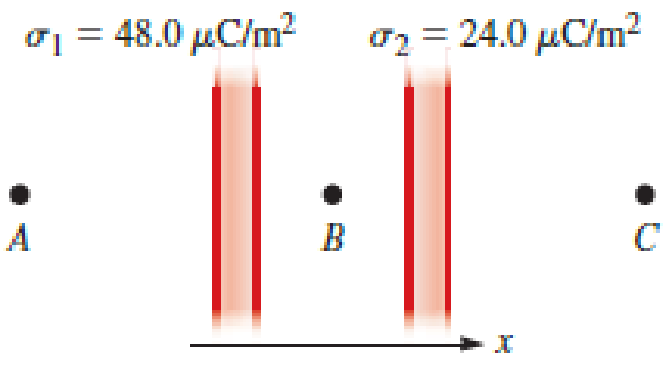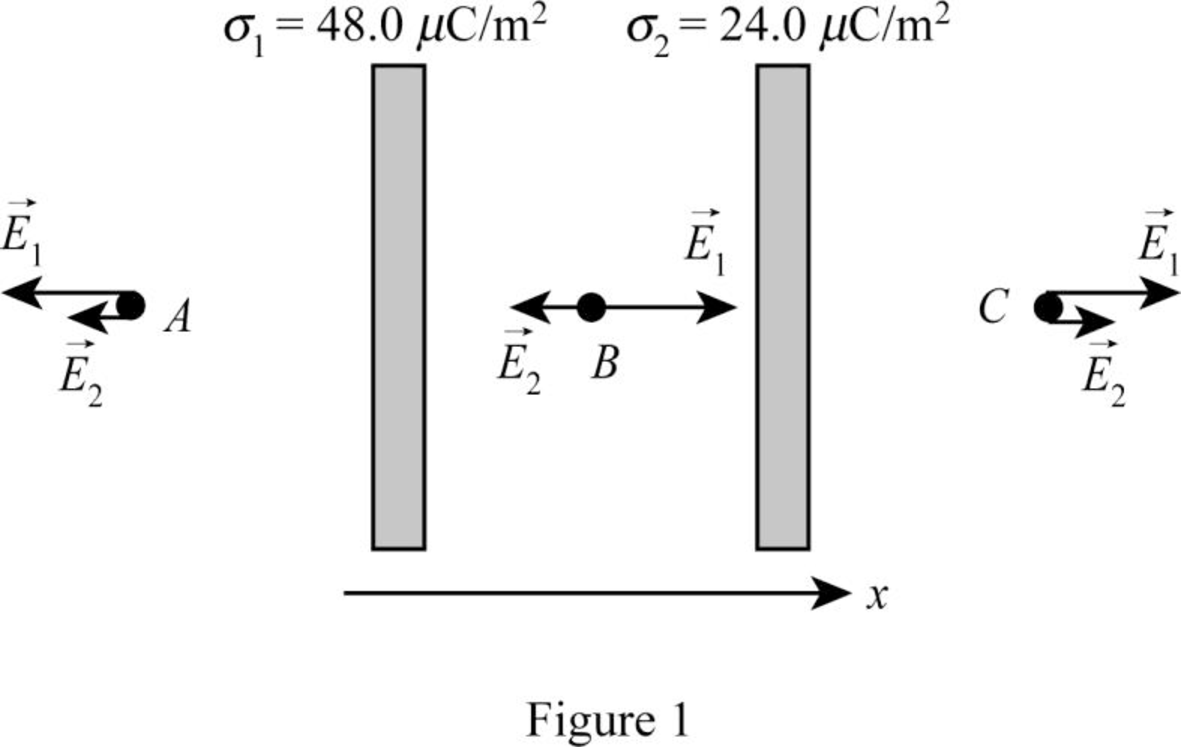
Concept explainers
The infinite sheets in Figure P25.47 are both positively charged. The sheet on the left has a uniform surface charge density of 48.0 μC/m2, and the one on the right has a uniform surface charge density of 24.0 μC/m2.
- a. What are the magnitude and direction of the net electric field at points A, B, and C?
- b. What is the force exerted on an electron placed at points A, B, and C?

FIGURE P25.47
(a)
The magnitude and direction of the net electric fields at points
Answer to Problem 47PQ
The magnitude and direction of the net electric fields at points
Explanation of Solution
Write the expression for finding the electric field due to first sheet.
Here,
Write the expression for finding the electric field due to second sheet.
Here,
The following figure shows the direction and the sum of the fields at points

Write the expression to find the electric field at point
Write the expression to find the electric field at point
Write the expression to find the electric field at point
Conclusion:
Substitute
Substitute
Substitute
Substitute
Substitute
Therefore, the magnitude and direction of the net electric fields at points
(b)
The force exerted on an electron placed at points
Answer to Problem 47PQ
The force exerted on an electron placed at points
Explanation of Solution
Write the expression for the force exerted on the electron.
Here,
Conclusion:
Substitute
Substitute
Substitute
Therefore, the force exerted on an electron placed at points
Want to see more full solutions like this?
Chapter 25 Solutions
EBK WEBASSIGN FOR KATZ'S PHYSICS FOR SC
- A toy car speeds up at 1.0 m/s2 while rolling down a ramp, and slows down at a rate of 2.0 m/s2 while rolling up the same ramp. What is the slope of the ramp in degrees? Grade in %? The friction coefficient?arrow_forwardPlz solution should be complete No chatgpt pls will upvote .arrow_forwardA box with friction coefficient of 0.2 rests on a 12 foot long plank of wood. How high (in feet) must one side of the plank be lifted in order for the box to begin to slide?arrow_forward
- A hydrogen atom has just a single electron orbiting the nucleus, which happens to be a single proton without any neutrons. The proton is positively charged, the electron negatively, but both with the same magnitude of charge given by e=1.602x10-19C. The mass of an electron is 9.11x10-31kg, and the proton is 1.67x10-27kg. Find the ratio of the electrostatic to the gravitational force of attraction between the electron and the proton in hydrogen. \arrow_forwardWhat is the third law pair to the normal force as you sit in a chair? What effect does the sun's pull on earth have in terms of third law pairs?arrow_forwardUsing Newton's 2nd law, show that all objects subject to the pull of gravity alone should fall at the same rate. What is that rate?arrow_forward
- No chatgpt pls will upvotearrow_forwardA cart on wheels (assume frictionless) with a mass of 20 kg is pulled rightward with a 50N force. What is its acceleration?arrow_forwardLight travels through a vacuum at a speed of 2.998 x 108m/s. Determine the speed of light in the following media: crown glass (n = 1.52)arrow_forward
 Physics for Scientists and Engineers: Foundations...PhysicsISBN:9781133939146Author:Katz, Debora M.Publisher:Cengage Learning
Physics for Scientists and Engineers: Foundations...PhysicsISBN:9781133939146Author:Katz, Debora M.Publisher:Cengage Learning Principles of Physics: A Calculus-Based TextPhysicsISBN:9781133104261Author:Raymond A. Serway, John W. JewettPublisher:Cengage Learning
Principles of Physics: A Calculus-Based TextPhysicsISBN:9781133104261Author:Raymond A. Serway, John W. JewettPublisher:Cengage Learning Physics for Scientists and Engineers with Modern ...PhysicsISBN:9781337553292Author:Raymond A. Serway, John W. JewettPublisher:Cengage Learning
Physics for Scientists and Engineers with Modern ...PhysicsISBN:9781337553292Author:Raymond A. Serway, John W. JewettPublisher:Cengage Learning Physics for Scientists and EngineersPhysicsISBN:9781337553278Author:Raymond A. Serway, John W. JewettPublisher:Cengage Learning
Physics for Scientists and EngineersPhysicsISBN:9781337553278Author:Raymond A. Serway, John W. JewettPublisher:Cengage Learning College PhysicsPhysicsISBN:9781938168000Author:Paul Peter Urone, Roger HinrichsPublisher:OpenStax College
College PhysicsPhysicsISBN:9781938168000Author:Paul Peter Urone, Roger HinrichsPublisher:OpenStax College College PhysicsPhysicsISBN:9781305952300Author:Raymond A. Serway, Chris VuillePublisher:Cengage Learning
College PhysicsPhysicsISBN:9781305952300Author:Raymond A. Serway, Chris VuillePublisher:Cengage Learning





